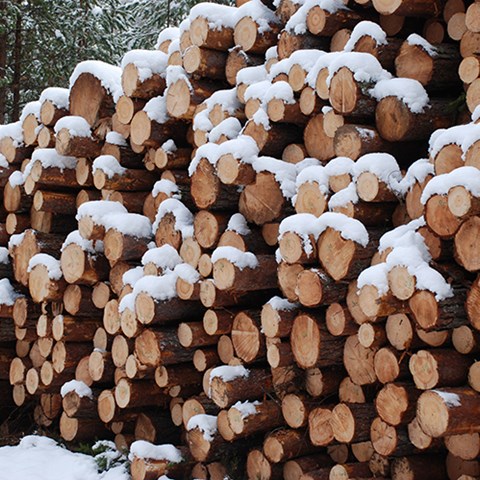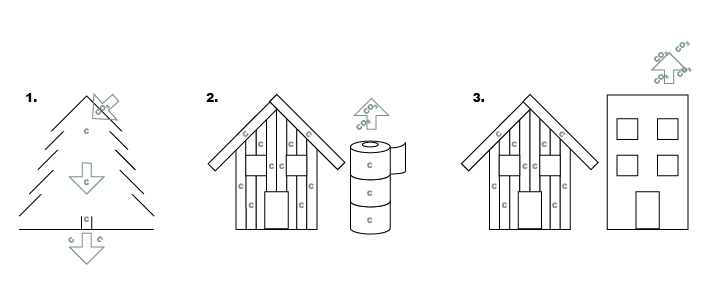Different assumptions regarding the use of wood products explain the difference
When it comes to aspect 3 however, different assumptions about the substitution effect, i.e., if and to what extent wood products substitute fossil fuels and products, make the studies differ on whether more or less harvesting is good for the climate. On the one hand, this is because there is a multitude of ways to use wood as a product or energy. On the other hand, it is important which fossil product is replaced and which management method was used to get the wood from the forest. For example, forestry with longer rotation times tends to produce larger higher and thicker trees that the construction industry can use more extensively to replace steel and concrete. This in turn leads to less pulpwood and products made from pulpwood, such as toilet paper.
Large uncertainty about the amount of fossil products replaced by wood
A more fundamental question is the amount of wood that replaces fossil products and energy. One option is to assume that all harvested wood leads to the replacement of fossil products as it is supplied to an industry engaged in the production of various wood products and wood-based energy. However, this is a very rough estimate and may lead to overly optimistic substitution effects. A more nuanced approach is instead to calculate the substitution effect only for the final wood products. Then typical "product pairs" can be matched, e.g., paperboard-based vs. petrol-based packaging, which gives more realistic comparisons. Moreover, this approach accounts for wood losses along the value chain, for example the fact that only half of the timber becomes sawn wood products, since by-products end up as energy or pulpwood. Moreover, if a product, such as writing paper, does not have a fossil counterpart or equivalent, then there is no substitution effect. However, even with this more nuanced approach, there is a wide variation in substitution effects depending on which "product pairs" are used and how carbon intensive the fossil products are. The carbon footprint of a fossil product can differ widely depending on which geographical region it originates from, e.g., if the product is produced using fossil or renewable energy.
To conclude, both approaches estimate substitution effects only in a limited way and thus cannot provide clear advice on the most climate-friendly forest management strategy. Both approaches assume that substitution effects arise solely from the supply of harvested wood or wood products and thus follow a "supply" perspective. However, here it is unclear whether wood products actually always replace an opposing fossil product, or whether wood products instead merely complement the market. After all, this is not determined by the supply of products, but by demand.
Demand for wood a better starting point?
An alternative approach is to use the demand for wood products to estimate substitution effects. How much and which wood products will be demanded in the future? Here the analysis does not start with the forest and how much is harvested, followed by the production of wood products, which ultimately leads to substitution. Instead, the direction is the reverse and the analysis starts with an explicit "product pair", e.g., wood frames instead of concrete and steel frames as load-bearing elements in buildings. This means that the substitution effect per product unit is clear from the outset but a possible future scenario is assumed, e.g., an increase in demand for timber frame. The demand for wood in the scenario assuming an increased use of timber frame is then compared with a reference scenario corresponding to the current situation. Thus, it is possible to compare the increase in carbon storage in wood products with the decrease in forest carbon due to increased harvesting (i.e. the biogenic carbon balance) and the impact of substitution on the fossil greenhouse gas balance. This approach thus solves the problems of the "supply” perspective mentioned above as the ability to substitute fossil products and energy with wood alternatives is ultimately dependent on demand decisions. However, the application of this alternative approach following a "demand" perspective still remains an exception.
Time decides what is climate-smart now and later
What the above reviewed studies agree on is that in the short term it is more climate-smart to leave more forests standing, but that in the long term it can be more climate-smart to actively manage forests. When the tipping point for this occurs depends on supply, demand and on how much both the forest- and the other fossil-based industries reduce their emissions.
This article is only concerned with carbon sequestration, storage in wood products and the substitution effect, but there are many other influencing aspects affecting the climate, such as how much sunlight is reflected by the forest. The question of forests and the climate benefits of forestry is an important and complex one with no easy answers. The climate benefits of forests also need to be balanced with other societal goals such as biodiversity, wood product and energy needs and the social values of forests.
Text: Jeannette Eggers, Maximilian Schulte

